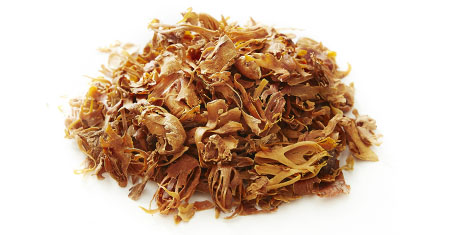What Is Mace?
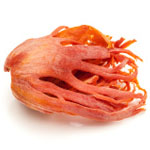
Mace has the botanical name Myristica frangrans. Mace, which comes from the same tropical fruit that produces nutmeg, has a softer, fruitier flavor than nutmeg. These whole pieces are suitable for adding to mulling spices or marinades. Mace is actually the threaded material that envelops the fruits of the nutmeg tree, covering the fruit sort of like veins would. Nutmeg, as you know it, is the fruit inside of these veins. The mace strings are usually chopped or ground before using.
Mace Plant and Cultivation
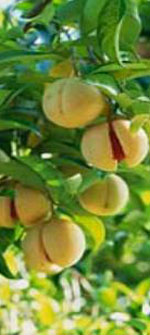
Mace comes from the nutmeg tree, Myristica fragrans. Nutmeg trees are a tropical evergreen tree that grow some 7-10 metres high (23-33ft), and have shiny green leaves that are dark on the upper side and pale-green beneath. Nutmeg trees are male or female and one male tree is needed per 10 female trees, so that the female trees can be fertilised and then bear fruit. Unwanted male trees are thinned out from the nutmeg plantation. Nutmeg trees become fully mature after 15 years and are fruitful for 40 years. When the fruit has developed, it looks like a yellow nectarine. When the fruit is ripe, the fruit is picked and the flesh cut off the shell, making sure the shiny, blood-red mace aril on the outside is not removed or damaged. The mace aril brings nourishment to the nutmeg seed (nutmeg spice), clinging tightly to the shell that encases the seed. The mace is peeled from the nutmeg shell and then dried in the sun for a few hours only and its shiny wet and irridescent redness dulls to a matt red-orange colour. The mace blades are stored in the dark for 4 months to dry out. Whole mace still often has the curved shape of the nutmeg shell and has its characteristic fingered shape.
Mace Description
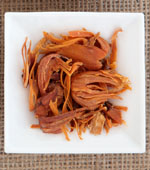
The nutmeg tree, Myristica fragrans, is the only tree that produces two separate spices. The fruit contains a hard pit, which is a nutmeg, while the lacy red membrane which surrounds it is mace. The delicate membrane is carefully peeled away from the shell of the nutmeg and spread to dry in the sun, fading from bright red to orangy-brown as it dries. Mace is a common ingredient in Northern European cooking, showing up in hearty vegetable dishes, cream sauces, and sausages. In baking, mace can be used as a substitute for nutmeg; its mellower flavor is especially nice with fruits or delicate pastries.
Uses of Mace
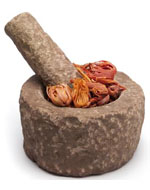
Mace powder has a distinct spicy-sweet taste and is used to flavor food, domestically and commercially. It is a commonly used ingredient in desserts and baked products like pies, milk custards, puddings, fruit dishes, biscuits, muffins, cakes and breads. The essential oils and nutrients present in mace powder are responsible for its medicinal value. Traditionally, it is known to be anti-fungal, anti-depressant, aphrodisiac, digestive and carminative agent. It is a good source of minerals like copper, potassium, calcium, manganese, iron, zinc and magnesium. It also is rich in B vitamins, Vitamin C, vitamin A and many flavonoid antioxidants like beta carotene and cryptoxanthins.
10 Health Benefits of Mace
1 - Muscular and Joint Pains - Mace oil has great abilities of treating muscular and joint pains and sores as it is an excellent sedative. It also has anti-inflammatory properties and can be very effective for curing arthritis, rheumatism, lumbago, etc. It plays an important role in Chinese medicines for treating abdominal pain and inflammation.
2 - Helps Digestive System - Mace is very handy for digestion and easing stomach aches and gas from stomach and intestine. Apart from encouraging appetite, it is beneficial for preventing indigestion, flatulence, vomiting and diarrhea.
3 - Treat Asthma - It is an important ingredient in many cough syrups and cold rubs as it helps in relieving cough and cold. Further, it is very effective in treating asthma.
4 - Reduce Stress - Since mace is a great stimulator, it stimulates the brain and eliminates any signs of mental exhaustion and stress. It can improve the quality of dreams, making them more intense and colorful. Mace can be considered as a good remedy for anxiety as well as depression. It enhances concentration and increases the overall efficiency at study and work.
5 - Dental Health - Mace is antiseptic in nature and is an important ingredient in several toothpastes. It effectively cures toothaches, aching gums, and bad breath.
6 - Treat Kidney Diseases - Mace is beneficial for treating kidney infections and kidney diseases. Besides, it is known for even dissolving kidney stones.
7 - Helps in Red Blood Formation - Copper And Iron Are Important For The New Blood Cell Formation. An Insufficiency In Iron May Result In Anemia, Fatigue, And Muscular Weakness.
8 - Boosts Blood Flow - Mace Spice has Capability to Enhance The Stream Of Blood. This May Keep The Pores And Skin And Hair Healthful, And Similarly Defend You From Dangerous Illnesses And Infections. Increased Blood Flow Additionally Enables Prevent Diabetes In Conjunction With Other Lifestyles-threatening Issues.
9 - Helps treat Insomnia - Mace Is Understood for excessive Content Of Magnesium, That Decreases Nerve Anxiety, And Additionally Energizes The Discharge Of Serotonin, Making A Sense Of Rest Or Even Sedation.
10 - Cold And Cough - Mace Spice Might Also Manage Bloodless And Cough! It Safeguards You Against Flu And Viral Problems And Continues The Frame Included And Secure From Illnesses. It Is Usually Utilized To Prepare Cough Syrups And Bloodless Rubs. Mace Spice Is Yet Another First-rate Treatment For Allergies Patients.
Producing Countries of Mace
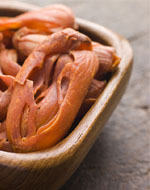
Indonesia and Grenada are the world's largest producers of high quality Nutmeg and Mace. Indonesia has close to 75% of the world market share with Granada having nearly 20% of the market share. The remaining 5% production is done by other countries including India, Malaysia, Sri Lanka, Papua New Guinea and other Caribbean islands such as St. Vincent.The nutmeg tree is native to a region known as the Spice Islands near tropical Indonesia and parts of Southeast Asia. Nutmeg trees are also found in Kerala, the southernmost state of India. The Dutch introduced Mace to Europeans, who at one time held an alarming spice monopoly in most of Southeast Asia.
Consuming Countries of Mace

The principal import markets of mace are the European Community, the United States, Japan and India. Singapore and Netherlands are one of the largest exporting countries of the spice.
Recipe for Beverages with Mace
St. Lucian Chocolate Tea
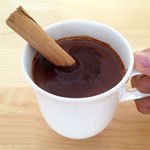
Ingredients: A: 4 ounces unsweetened cocoa power B: 1/2 tablespoon lime zest C: 1/4 teaspoon cinnamon D: 1/8 teaspoon nutmeg E: Pinch of mace F: Pinch of cayenne powder G: 2 cups milk (add more if you prefer a thinner consistency) H: 1 whole bay leaf I: 1 whole star anise J: 1 whole vanilla bean or 1/4 tsp. vanilla extract K: 3/4 cup sugar
Preparation MethodA: In a small mixing bowl combine the chocolate, zest, cinnamon, nutmeg, mace, and cayenne. B: In a small saucepan warm the milk. Stir to avoid scalding. C: Add the bay leaf, star anise, vanilla bean, and sugar. Bring to a simmer and whisk in the chocolate mixture. Whisk well as it cooks to prevent lumping. Simmer the mixture for eight to ten minutes until slightly thickened and rich.
Recipe for Cooking with Mace
Potted Shrimp with Mace Butter
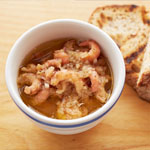
Ingredients: A: 3 shallots, finely diced B: 2 garlic cloves, minced C: 1 tsp ground mace D: 1/4 tsp cayenne pepper E: 1/2 tsp paprika F: 1 tbsp of rapeseed oil G: 250g of clarified butter H: 250g of brown shrimp, cooked and peeled I: flaky sea salt J: 4 slices of sourdough bread, toasted
Preparation MethodA: Heat the oil in a saucepan over a medium heat. Sauté the shallots and garlic for 1 minute, then add the spices and cook for a further 3 minutes. B: Add the butter and season well with salt. Remove the pan from the heat and stir in the brown shrimp – they should be just warm. C: Divide the shrimp between 4 ramekins and serve with toasted sourdough bread.
Recipe for Dessert with Mace
Pear Gingerbread Tart in Mace & Salted Caramel

Ingredients: A: 1 pear B: 3 tablespoons of ready-made salted caramel sauce C: 1/2 Pack of ready-made Gingerbread dough D: 2-3 petals of mace E: butter for tin greasing
Preparation MethodA: Preheat your oven to 180c and grease a tart tin. B: Place the salted caramel and mace in a small heat-proof bowl and set it in a pan of hot water to simmer gently until the caramel is melted and is fully liquid. Infuse the mace for 20 mins. C: Roll out the gingerbread dough and place in the tart tin with edges overhanging. Push the dough carefully into the corners of the tin, then cut the edges off with a sharp knife and prick the base all over with a fork. D: Bake the gingerbread for 5-10 mins until golden. Remove from the oven and leave to cool. E: Wash, dry and thinly slice one pear. Layer the tart base with the pear and drizzle the caramel sauce all over. F: Place back in the oven and bake for another 10 mins. Leave to cool before serving.

